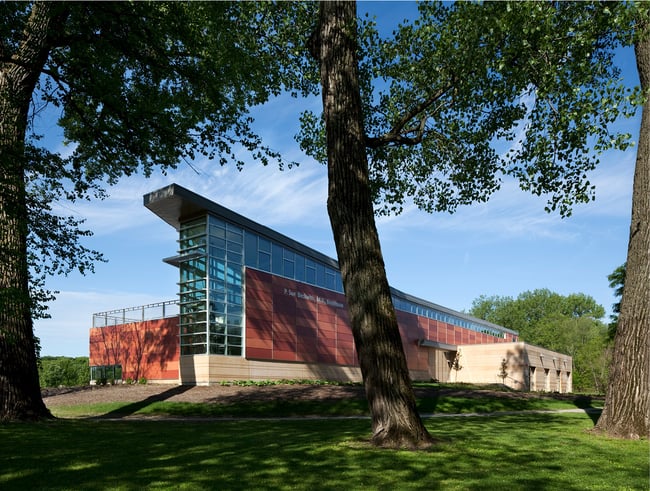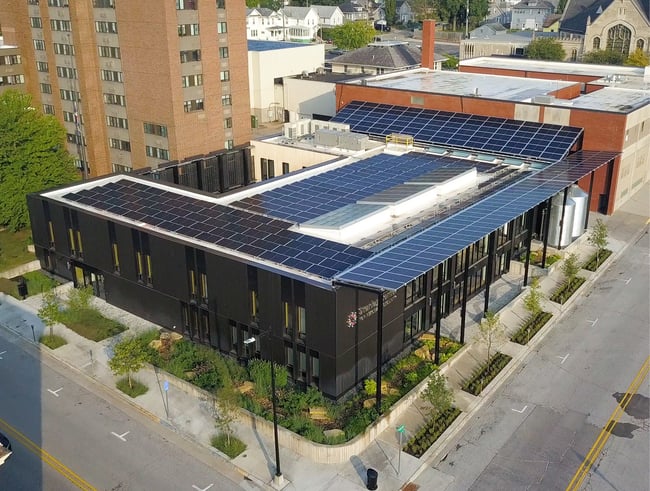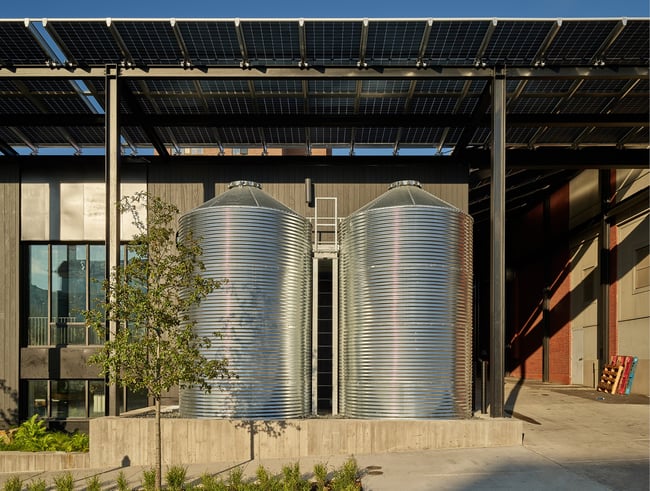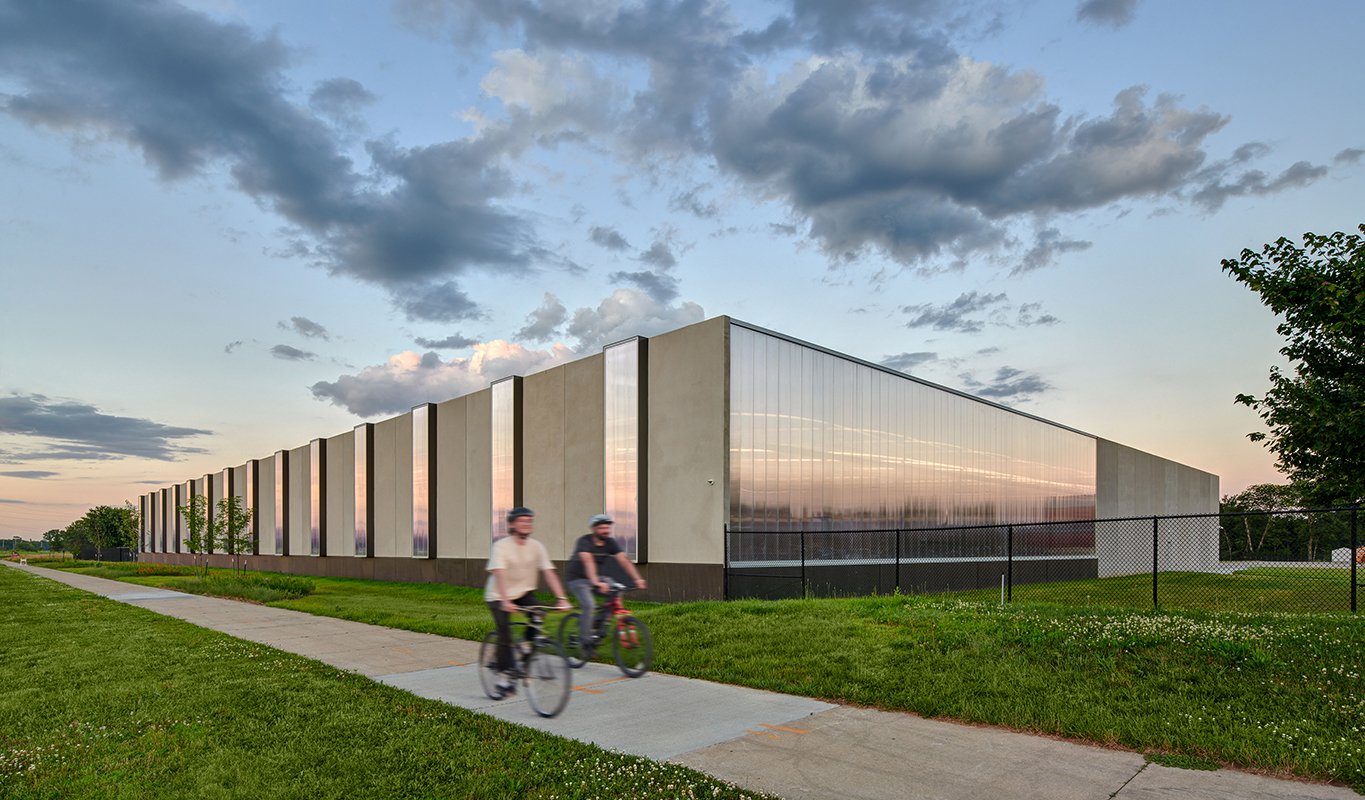Similarities Between LEED and LBC
Both LEED and LBC focus on every aspect of building design, providing a comprehensive approach to sustainability. They differ from certification systems like WELL and Passive House which focus on more specific aspects of green design.
As full-building certification systems, both LEED and LBC have requirements related to:
- Energy consumption
- Water use
- Materials
- Human health
- Site selection and development
Both systems encourage an integrated project delivery method, with architects, contractors, consultants, and owners working toward a common goal. Contractors should join the process early to collaborate with the design team.

Both LEED and LBC address site selection and development.
Additionally, LEED and LBC encourage sustainable synergies—design strategies that address multiple goals. These similarities make both systems solid options for anyone seeking a robust, verifiable approach to sustainability. They can help you achieve energy performance goals, improve occupant well-being, and lower operational costs.
At the same time, they fit a range of project types—from single-family homes to large-scale commercial developments—and can be adapted to different locations and climates.
Differences Between LEED and LBC
Although both LEED and LBC focus on similar aspects of building design, they differ in many ways.
Certification Requirements
One of the most significant differences is their certification requirements. LEED uses a point system, and depending on the number of points achieved, projects can earn one of four certifications:
- Certified (40-49 points)
- Silver (50-59 points)
- Gold (60-79 points)
- Platinum (80+ points)
Some LEED strategies—called prerequisites—are required for all projects. Beyond the prerequisites, project teams can choose which strategies to incorporate.
The LBC, on the other hand, is divided into seven categories known as Petals. Each Petal has separate requirements called imperatives for a total of 20.
Although fully certified projects must achieve all 20 imperatives, the LBC offers two other certification pathways. CORE-certified projects must achieve the ten “core” imperatives, and Petal-certified projects must achieve the ten imperatives plus all the imperatives in the Energy, Water, or Materials Petal.

Fully certified Living Buildings must meet the program's energy requirements.
These additional certification pathways make the LBC available to more project types. Some projects—especially those in leased spaces—may struggle to achieve every LBC requirement, making the CORE and Petal pathways more accessible.
LBC certifications are also based on actual performance and occur after a full performance year. This approach differs from LEED, which bases its certifications on modeled or expected performance.
Initial Costs
From a cost perspective, LEED and LBC involve certification fees and third-party services, including commissioning and energy consulting. LBC may require additional experts to meet water and material imperatives, leading to a higher initial cost.
At the same time, LBC has more stringent material requirements. For example, project teams must avoid “Red List” materials known to harm human and environmental health.
Many product manufacturers have not caught up with LBC standards, and finding alternative, healthy materials can be challenging. Project teams may have to pay a premium for vetted products and systems, increasing construction costs and fees.
Industry Knowledge
LEED has long been a sustainable design trailblazer. It has been around for decades, and many in the design and construction industry are familiar with its practices.
LBC, on the other hand, has yet to catch up with LEED’s popularity. Its practices—especially those related to water and materials—are novel and unconventional. As such, LBC projects require more coordination with contractors, municipalities, and product manufacturers. Project teams should prepare more time for research, advocacy, and community engagement.

LBC water strategies may require additional city approvals.
At the same time, LBC may require more from an operational perspective. Teams may need to train facilities staff on the building’s systems and equipment—especially water and energy systems.
Which is Right for You?
Often, LEED is described as “doing less bad.” It seeks to minimize the negative impacts of the built environment and improve building performance beyond baseline standards.
The LBC, on the other hand, promotes “regenerative” design practices. Rather than minimizing harm, it seeks to create a positive impact on people, communities, and the planet.
Ultimately, the right choice comes down to your values and goals. LEED works well for those wanting to do better than they have in the past. Its practices are well-known, providing an accessible path toward sustainability.
The LBC works well for those wanting to make a statement. It goes further with its requirements, pushing the boundaries of sustainability beyond generally accepted practices. Organizations need to commit to the LBC’s requirements and go “all in” on sustainability.
A Living Building can also serve as a market differentiator. Although thousands of buildings have achieved a LEED certification, there are few fully certified Living Buildings. Organizations wanting to stand out and demonstrate their values may find the LBC to be a better fit.
Discover Other Building Certification Systems
LEED and LBC are great options for any organization interested in sustainable design. Each system reduces carbon footprints, improves energy performance, and benefits occupants.
While LEED is well-known and accessible, the LBC goes further with its requirements. These requirements can add complexity to a project, and organizations should prepare by allowing time in the design schedule for research, advocacy, and consultancy.
Although LEED and LBC are great options, there are many other building certification systems. Some systems have a narrower focus. WELL, for example, focuses on occupant health and well-being, and Passive House focuses on energy performance and operating costs.
Learn more by reading about WELL and Passive House and their requirements.

